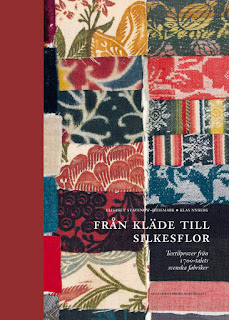This book is written in Swedish only; there is no parallel text in English like in "18th Century Textiles". This makes sense, as the samples are all from Swedish factories. Still, it includes a lot of samples from fabric types that may not be published elsewhere. E.g., many of the fabric names below are mentioned in "Textiles in America 1650–1870"—but without pictures.
 |
| Front cover, featuring some samples from 1751 |
Roughly 30 % of the sample pages are broadcloth (mostly dull colors, for menswear?), 30 % are other woolen and/or worsted fabrics, 25 % are silks, 10 % linen and/or cotton, and 5 % ribbons (some are silk, others linen). The distribution varies between the three different collections:
1744-1746
35 pages of samples, mostly broadcloth (sevaral pages), woolens and worsted fabrics—including a few samples of boj (bay), rask (rash), caffa (caffoy), schagg (shag), schalong (shaloon), droijett (drugget), stamett (stammet), camlott (camblet), sarge (serge), as well as a few patterned linen weaves. There's also a single page dated 1737 with samples of silk velvet (short nap) and silk plush (very long nap). All samples are arranged by manufacturer. Note that some of the broadcloth samples look like black in the photo, but the explanatory text says they are green, so they must be really dark green.1751
 | |
| Cotton samples, 1751 |
My favorites this year are the samples of striped cotton/linen fabrics, by four different manufacturers. They really give you an idea of period colors. One company's samples are striped in shades of blue on white, while another uses red or pink too, and a couple use several colors. Symmetry seems to have been very important—the wide stripe near the bottom left corner is the only asymmetrical stripe in the entire book.
1766
About 35 pages, including 20 pages of silk samples, and several pages of mostly worsted fabrics. The samples are arranged by type rather than manufacturer.Some of the silks are really nice. There's silk velevet (cut, or uncut with patterns), droguet, patterned silk satin, bordaloux (shagreen), gauze, damask, checked taffeta, and other taffetas patterned with floats of contrasting colors forming stripes or largish square dots.
 |
| Shagreen (left) and other silk samples, 1766 |
Further contents
This book is really a sample collection combined with an anthology on the Swedish 18th century weaving industry and its fabric production. The anthology is probably only of interest within Sweden, which justifies the decision to publish the book in Swedish only. But I can't help thinking that a lot of the samples would be interesting to people elsewhere too, so it would've been nice if they'd included English fabric names as well!All in all, I really like this book, and use it about as often as "18th century Textiles".
Ordering information
This book is available from Swedish online bookstores—but international bookstores don't carry it as far as I know. If you're interested in this book, but live outside Sweden, please contact the publisher and ask if you can order from them directly. At first, their website said the minimum order was three copies, but that text has now been removed.And, if you live in Sweden, remember that you can always take a look at the book through inter-library loan before you decide whether you want a copy of your own!
No comments:
Post a Comment